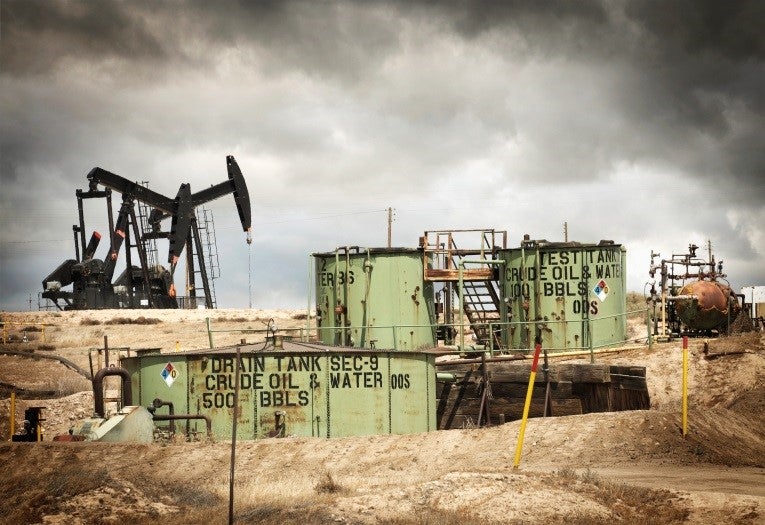 For decades communities in California who live close to oil and gas facilities have reported experiencing unbearable odors of gas, headaches, nausea, respiratory problems, and even cardiac complications as a result of the industry’s emissions. The health impacts of oil and gas pollution were made crystal clear last year after a massive gas leak at a Southern California storage facility led to mass hospitalizations and forced hundreds of families to evacuate their homes.
For decades communities in California who live close to oil and gas facilities have reported experiencing unbearable odors of gas, headaches, nausea, respiratory problems, and even cardiac complications as a result of the industry’s emissions. The health impacts of oil and gas pollution were made crystal clear last year after a massive gas leak at a Southern California storage facility led to mass hospitalizations and forced hundreds of families to evacuate their homes.
But massive gas leaks like the one at Aliso Canyon aren’t the only cause for alarm. A string of new reports confirm what many concerned communities have known for years: oil and gas emissions from across the entire supply chain can wreak havoc on our health, and are often higher than experts previously thought.
Toxic chemicals, many sources
One report from the California Air Resource Board (CARB) looked at data collected from 39 different production facilities across the state. Of the 211 different gas leaks recorded, nearly half of them included the cancer-causing chemical benzene. According to the Centers for Disease Control, chronic exposure to this toxic carcinogen can also cause leukemia, blood disorders and reproductive problems. High levels can affect the central nervous system and even lead to death. While it is unclear from the report whether the leaks occurred near residential areas, the frequency at which toxic chemicals were measured is concerning.
This is not solely a problem at production facilities. A separate CARB study focused on emissions from the ponds where drillers store wastewater that comes from oil extraction. According to the report, some California wastewater ponds emit substantial levels of toxic air contaminants like benzene, toluene, ethylbenzene and xylene. This is problematic given that California allows some of this wastewater to be directly injected into aquifers that millions of Californians rely on for drinking water.
Emissions are higher than we thought
Not only are researchers finding toxic emissions coming from all segments of the supply chain, they are also measuring emissions at higher levels than previously estimated.
In one recent study, methane emissions from three different refineries were anywhere from 11 to 90 times higher than what had been reported to the federal government. In another study the South Coast Air Quality Management District conducted mobile monitoring around six different refineries and crude oil processing facilities in the South Coast air basin in 2016. In the study, they measured smog-forming pollutants at levels that were up to 12 times greater than what refineries reported to local officials. Smog and other types of air pollution reportedly kill more than 5.5 million people a year. These higher-than-expected levels of pollution not only threaten public health, it also verifies that the manner in which emissions have been reported may be inadequate and misleading.
Additionally, a 2017 Lawrence Berkeley National Laboratory study found that methane emissions in California’s Bay Area are approximately twice as high as previously believed. While, not a direct threat to our health, this is particularly troubling news for our climate since methane is responsible for about a quarter of current global warming.
Emissions from transmission and distribution pipelines, as well as natural gas storage facilities, also are higher than previously reported according to a report commissioned by CARB and the California Public Utilities Commission (CPUC). The report finds that methane emissions increased 70% from 2014 to 2015 – most likely due to better reporting requirements and the use of new technology to find gas leaks that had been persisting all along.
Using the data to deliver results through smart regulations
California has made good faith efforts to try to fight dangerous emissions. The state’s signature climate legislation, SB 32 and its predecessor AB 32, aims to reduce 40% of California’s climate pollution by the year 2030, and part of that plan includes recommendations for oil and gas utilities to reduce emissions from leaky pipelines. According to CARB’s Scoping Plan, refineries may also be required to reduce emissions by 20%.
This progress is promising but there is more to do, especially since the impacts of runaway emissions can persist over time. Case in point: months after the Aliso Canyon leak was plugged, researchers detected trace levels of benzene, toluene and xylene in the air. Researchers also found traces of barium in the dust at homes near the leak. When combined, these chemicals may have produced symptoms like headaches, nausea, and nose-bleeds reported months after the incident occurred.
The fact that we continue to find toxic pollutants with such frequency near oil and gas facilities should be an alarm bell to the leaders in Congress who are trying to strip away protections that could directly benefit public health. It should also signal to CARB and the CPUC the need to finalize strong policies that reduce methane emissions and co-pollutants like benzene from the vast majority of oil and gas facilities and pipelines across the state. We’ve seen the data, now we must put it to work.









